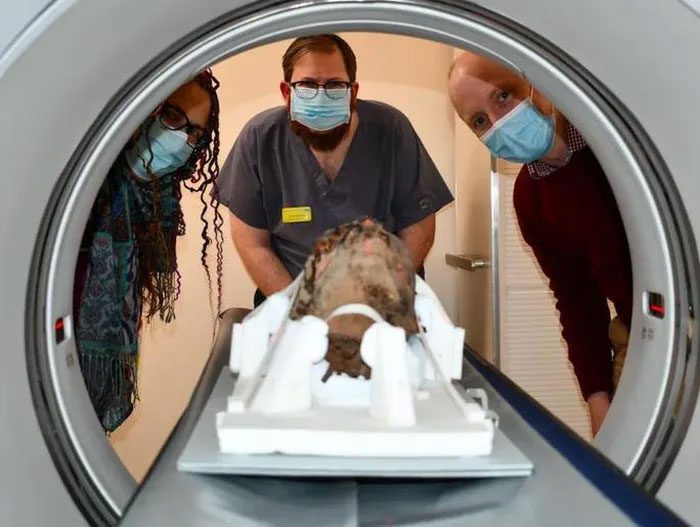The examination results reveal that the human head belonged to a woman who was mummified according to the standards of ancient Egypt, but there is an unusual detail inside the nose.
A human head containing valuable scientific data has been discovered in an attic in Kent, England. Researchers from Canterbury Christ Church University have examined and conducted a CT scan of the specimen, confirming that it is the head of a 2,000-year-old Egyptian mummy.
Incomplete data suggests that the head may have been purchased from Egypt as a souvenir in the 19th century. It is the head of a woman, which has suffered significant damage to the facial area possibly due to the process of tomb robbing and subsequent sales among many hands; however, the internal details remain remarkably intact.

Scientists beside the human head being scanned – (Photo: CANTERBURY CHRIST CHURCH UNIVERSITY/MAIDSTONE HOSPITAL)
According to Business Insider, preliminary results from the CT scan at Maidstone Hospital indicate that her teeth were worn down due to a diet consisting of quite a bit of coarse, hard food; however, her tongue was preserved very well.
The unusual detail inside the human head is an unidentified material within the left nostril and spinal canal, which may be related to the removal of the brain from the mummy.
Egyptians typically removed the internal organs of mummies, with the brain often extracted through the nose, while the organs were placed in ceramic jars buried with the mummy. This was to ensure that the mummy would be difficult to decompose.
The head has been donated to the collection of the Canterbury Museum and Gallery. Scientist Craig Bowen, who manages the collection, told Kent Online that the human head was discovered by a man who inherited the property from his brother.
The brother is believed to have obtained it from a “Dr. Coates” sometime in the early to mid-20th century, but other details remain completely vague.
Dr. James Elliott from Canterbury Christ Church University, who led the CT scanning team of the mummy’s head, stated that the scanning process provided a wealth of information regarding oral health, pathology, preservation methods, and it also aids in estimating the age and gender of the woman.
The research team intends to use the data to reconstruct the face, bringing the mysterious Egyptian woman back to the present.





















































